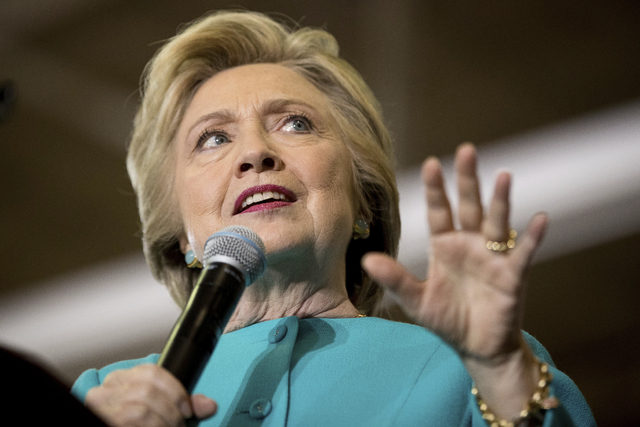NEW YORK — Hillary Clinton appears on the cusp of a potentially commanding victory over Donald Trump, fueled by solid Democratic turnout in early voting, massive operational advantages and increasing enthusiasm among her supporters. ADVERTISING NEW YORK — Hillary Clinton
NEW YORK — Hillary Clinton appears on the cusp of a potentially commanding victory over Donald Trump, fueled by solid Democratic turnout in early voting, massive operational advantages and increasing enthusiasm among her supporters.
A new Associated Press-GfK poll released Wednesday finds that Clinton has grabbed significant advantages over her Republican rival with just 12 days left before Election Day. Among them: consolidating the support of her party and even winning some Republicans.
“I’m going to pick Hillary at the top and pick Republican straight down the line,” said poll respondent William Goldstein, a 71-year-old from Long Island, New York, who voted for Mitt Romney in 2012. “I can’t vote for Trump.”
Overall, the poll shows Clinton leading Trump nationally by a staggering 14 percentage points among likely voters, 51-37. That margin is the largest national lead for Clinton among recent surveys. Most have generally shown her ahead of Trump for the past several weeks.
The AP-GfK poll finds that Clinton has secured the support of 90 percent of likely Democratic voters, and also has the backing of 15 percent of more moderate Republicans. Just 79 percent of all Republicans surveyed say they are voting for their party’s nominee.
With voting already underway in 37 states, Trump’s opportunities to overtake Clinton are quickly evaporating — and voters appear to know it. The AP-GfK poll found that 74 percent of likely voters believe Clinton will win, up from 63 percent in September.
Troubles with President Barack Obama’s signature health care law have given Trump a late opening to warn voters against putting another Democrat in the White House. And the poll was taken before the government projected sharp cost increases.
But even Republicans question whether the rising price of insurance premiums is enough to overcome the damage the businessman has done to his standing with women and minorities.
“Donald Trump has spent his entire campaign running against the groups he needs to expand his coalition,” said Whit Ayres, a Republican pollster who advised Florida Sen. Marco Rubio’s failed presidential campaign. Ayres called Trump’s campaign “strategically mindless.”
Even if Clinton’s support plummets in the contest’s closing days, or she’s unable to motivate strong turnout in her favor, it’s not clear that Trump could marshal the resources to take advantage and collect enough states to win the 270 electoral votes needed to claim the White House.
Clinton’s team has overwhelmed Trump’s campaign in its effort to turn out voters.
An Associated Press review of campaign finance filings finds that her campaign, the Democratic National Committee and Democratic parties in 12 states have more than three times as many paid employees as Trump’s campaign and the main Republican organizations supporting him. Clinton and Democrats had about 4,900 people on payroll in September, while Trump and Republicans had about 1,500.
Both sides benefit from legions of volunteers knocking on doors and making phone calls to voters, as well as outside forces such as unions and super PACs pitching in on voter turnout operations. But key Republican groups such as the ones funded by the conservative billionaire Koch brothers are sitting out the presidential race because of their distaste for Trump, further extending Clinton’s likely advantage at getting out the vote.
The strength of the Democratic turnout effort appears to be paying dividends in states where voting is underway. Nationwide, more than 12 million voters have already cast ballots, according to data compiled by the AP, a pace far quicker than 2012.
In North Carolina, a must-win state for Trump, Democrats lead Republicans in early ballots, 47 percent to 29 percent. The Democrats hold an advantage even though turnout among blacks, a crucial voting bloc for Clinton in the state, is down compared to this point in 2012. Strategists in both parties attribute the lower black turnout in part to an early reduction in polling stations, though more sites are to open in the days leading up to Nov. 8.
In Florida, a perennial battleground, Democrats have drawn even to Republicans in votes cast, reaching that milestone faster than in 2012. Traditionally, Republicans do well initially with mail-in ballots. But Democrats were able to keep it close, putting Clinton in position to run up the score during in-person voting.
Clinton also appears to hold an edge in Nevada and Colorado based on early returns. David Flaherty, a Republican pollster based in Colorado, said the data signal “a Democrat wave in the making.”



